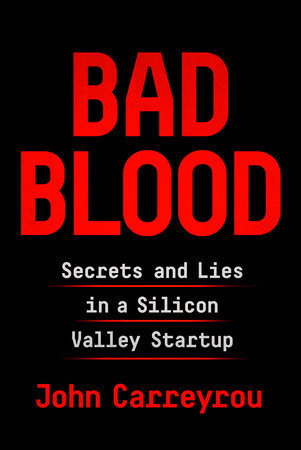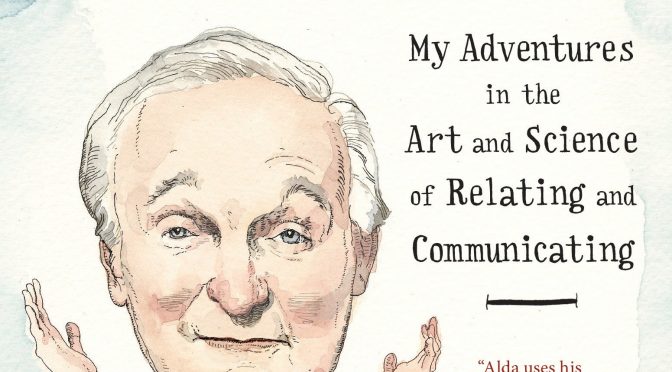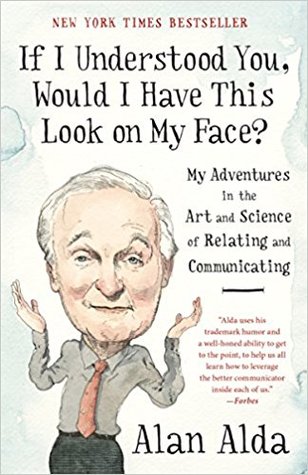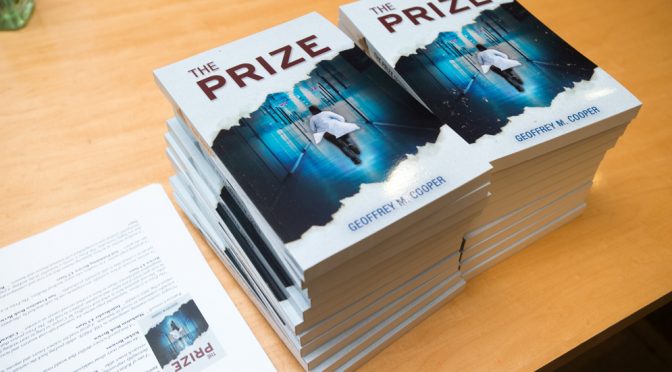I began to read more than usual because of social distancing, going through the list of books I had been planning to read for a while. One of the books that was recommended by a friend was “Bad Blood – Secrets and Lies of a Silicon Valley Startup” by John Carreyrou [1], based on the rise and fall of the blood-testing company, Theranos. I was especially interested in it given its relevance to the biotech industry and on recently finishing the book, I realized GSBS students might also find it interesting and thought of sharing a little bit about it. While there are plenty of resources out there that help you understand how to search for a job, determine if it is a good fit and notice red flags, this book paints a picture of life in the biotech industry, both as an entrepreneur and as an employee. I think students interested in careers in industry, entrepreneurship, venture capital, or science policy will gain some perspectives from reading this book. For instance, the book portrays the harsh reality of working in industry when a team of engineers were laid off because the research was headed in a new direction and they were not needed there anymore.

In January 2003, a 19-year-old Elizabeth Holmes founded Theranos with the vision of enabling multiple diagnostics tests to be run from a small volume of blood obtained from a finger-prick rather than the traditional venous blood draw, using the company’s small, portable, automated devices. In October 2015, a reporter from the Wall Street Journal, John Carreyrou, published an article [2] revealing that the company has been misleading investors and consumers, that the blood tests analyzed by Theranos devices were inaccurate and unreliable, and that a lot of the tests were actually performed by third-party commercial analyzers. Expanding the article into a book, Carreyrou walks us through how the company was formed, how it grew to become one worth over $9 billion, and finally, how it dissolved in September 2018 [1]. It is common knowledge that most, if not all, companies in Silicon Valley have skeletons in their closets that make headlines when they are revealed. However, fraud and irresponsibility by a health technology company like Theranos, and at such a massive scale at that, is even more dangerous considering the direct harm to patients’ lives. It is shocking that a company could get so far with technology that never performed as promised, and Carreyrou lays out the various scenarios and circumstances that contributed to it.
This book exemplifies the importance of validated and peer-reviewed data, the need for rigorous testing and quality-control checks, and the need for adhering to regulations – things we already know and are trained to practice. The book also highlights the need for communication within and between different departments in a company, so employees are aware of what stage of development the product is in, identify what exactly is holding up progress and work together to solve the problem. This lack of communication and the unusually high level of secrecy was frustrating to the employees at Theranos [1]. It is therefore important to find a balance between protecting proprietary information and facilitating communication to ensure highest productivity. Besides the need for effective communication between employees, the book also shows how there is a need for open, honest communication and understanding between the employees directly involved in developing the product and higher-level management. Without it, as a leader, you risk facing the dangers of being surrounded by yes-men – a false sense of security that you are doing things right, that the technology is working perfectly, experiments are returning expected and reliable results, and experiments that are not actually feasible can be done – hence wasting both time and money. You do not improve because you do not know where improvements are needed. However, at Theranos, the yes-men were not the only ones contributing to this culture. Holmes was not only a bad listener; she seemed to consider anyone who challenged her as disloyal [1]. She was surrounded by yes-men because she did not foster an environment that welcomed ideas, suggestions, and opinions opposite her own. Employees did not come forward with concerns because they did not want to get fired. This may be especially true of employees with H1-B or other work visas who have much more to lose, considering how their ability to stay in the country is tied to their employment. Abuse of H1-B visa workers is not unheard of; a recent example is Cloudwick Technologies Inc., based in Newark, California, paying their H1-B employees a much lower salary than what was agreed upon, and making illegal deductions from their salaries.
A negative (and savage!) review on the Glassdoor website (a website where employees can leave information about a company they work or worked in, such as CEO approval ratings, company reviews, salary reports) mentioned in the book prompted me to look at what else the ex-employees of the company had to say. Many of the reviews for Theranos are very detailed, with some ex-employees especially taking the time and effort to explain the “Pros” and “Cons” of working there. The most common “pro” mentioned was free food and snacks – something we, as grad students, can easily relate to. The “Cons” part of the negative reviews is where things got interesting. You could get an insight into how the employees felt and how they were treated. Most of them were overworked and underappreciated. It may be typical of employees to put in extra hours or feel like they have no work-life balance at a start-up firm, but at Theranos, they would not only track the number of hours the employees would spend at work, but would also monitor their social media activity [1]. The employees’ dedication was measured by how long they stayed at work and whether they would come in during the weekends. I imagine such a working environment would be suffocating and counterproductive, and it was no surprise that the employee turnover was high. What you can also glean from the reviews is the shattered hopes and dreams of the employees who were inspired by Holmes’s visions and dedicated their time to actualize it. As scientists, we all hope to contribute to making this world a better place. On top of not being able to do that at Theranos, they also feared that their time in the company will work against them in future applications. The book also mentioned how the HR department would post fake positive reviews on Glassdoor, and some of the reviews did spin the “cons” in a way to show Theranos in a positive light. For example, one of the reviews listed the cons as “truths” with statements like, “If you are unable to work in a highly self-directed environment where you are counted upon to create clarity from ambiguity, you will not be successful at Theranos.” This reminded me of reading about people answering the common interview question “What is your biggest weakness?” with “I work too hard.”
All things considered, Theranos did not really ruin the prospects of a biotech-startup in Silicon Valley. As a couple of articles in Wired mentioned, investors may be more skeptical now and that may actually be better. The increased scrutiny will hopefully mean rigorously tested data and more valid claims. Carreyrou points out how tech companies usually exaggerate about how their devices perform, but the same cannot be done with a medical device. No one ever died from a buggy Candy Crush app, but a misdiagnosis can be potentially fatal.
It is also interesting how Elizabeth Holmes and her downfall (from a net worth of $4.5 billion to zero) is discussed by the public. After she and her company were exposed for fraudulent practices, the focus skewed towards her appearance rather than her transgressions. They talked about how her unblinking stare (described as a “hypnotic” gaze in the book) is “sociopathic”, how she is not naturally blond, how her makeup is weird, and her deep, baritone voice is fake. Also, concerns about Theranos’ technology and the company’s practice were brought forward to some highly intelligent and experienced investors. Granted, they were not experts in the field of medical technology, but it would not be difficult to get an expert’s opinion and some of them were indeed alerted about Theranos by experts. If they genuinely did not have the power, even as a member of the company’s board of directors, to do anything about Holmes, why continue to be investors and not step down? Were they all simply manipulated and “bewitched” [1] by Holmes’s charm?
People have lots of ideas and opinions on where things went wrong, what Holmes could have and should have done, but the bottom line is, she blew the chance to be an inspirational leader and a role model. The struggle of female entrepreneurs, especially women of color, is no secret. Holmes did have a better chance than most women to become the “first female billionaire tech founder” [1] – she is smart, motivated, hard-working, charismatic and understands how Silicon Valley operates. She comes from a privileged family, had access to opportunities and was well-connected enough to benefit from the support of famous investors at a very early stage of the company. It is unfortunate that what was going to be a huge success story is now in the news for all the wrong reasons.
This book is a cautionary tale for biotech start-up founders and venture capitalists interested in biotech start-ups – providing insight into what makes an effective leader and the responsibilities that come with it, and what employees and venture capitalists should look for when looking to work or invest in a biotech firm. In my opinion, the story of Theranos could be an interesting case study for discussion in an ethics class or at the Tufts Biomedical Business Club. Regardless of whether you are interested in the biotech industry, I think anyone who is a fan of thrillers will enjoy this book. For those interested in something more visual and/or sensationalized, there is an HBO documentary covering this story called “Inventor: Out for Blood in Silicon Valley” and a movie based on Carreyrou’s book is set to release sometime this year.
References:
[1] Carreyrou, John. Bad Blood: Secrets and Lies in a Silicon Valley Startup. New York, Knopf Publishing Group, May 21st, 2018.
[2] John Carreyrou, “A Prized Startup’s Struggles,” Wall Street Journal, October 15, 2015.




